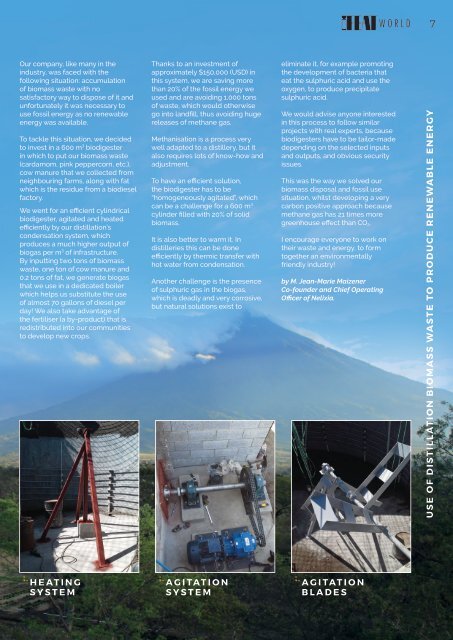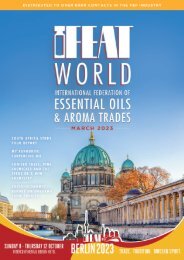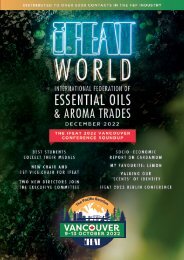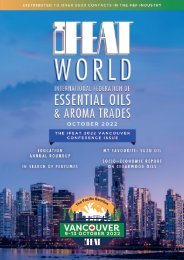You also want an ePaper? Increase the reach of your titles
YUMPU automatically turns print PDFs into web optimized ePapers that Google loves.
WORLD 7<br />
Our company, like many in the<br />
industry, was faced with the<br />
following situation: accumulation<br />
of biomass waste with no<br />
satisfactory way to dispose of it and<br />
unfortunately it was necessary to<br />
use fossil energy as no renewable<br />
energy was available.<br />
To tackle this situation, we decided<br />
to invest in a 600 m 3 biodigester<br />
in which to put our biomass waste<br />
(cardamom, pink peppercorn, etc.),<br />
cow manure that we collected from<br />
neighbouring farms, along with fat<br />
which is the residue from a biodiesel<br />
factory.<br />
We went for an efficient cylindrical<br />
biodigester, agitated and heated<br />
efficiently by our distillation’s<br />
condensation system, which<br />
produces a much higher output of<br />
biogas per m 3 of infrastructure.<br />
By inputting two tons of biomass<br />
waste, one ton of cow manure and<br />
0.2 tons of fat, we generate biogas<br />
that we use in a dedicated boiler<br />
which helps us substitute the use<br />
of almost 70 gallons of diesel per<br />
day! We also take advantage of<br />
the fertiliser (a by-product) that is<br />
redistributed into our communities<br />
to develop new crops.<br />
Thanks to an investment of<br />
approximately $150,000 (USD) in<br />
this system, we are saving more<br />
than 20% of the fossil energy we<br />
used and are avoiding 1,000 tons<br />
of waste, which would otherwise<br />
go into landfill, thus avoiding huge<br />
releases of methane gas.<br />
Methanisation is a process very<br />
well adapted to a distillery, but it<br />
also requires lots of know-how and<br />
adjustment.<br />
To have an efficient solution,<br />
the biodigester has to be<br />
“homogeneously agitated”, which<br />
can be a challenge for a 600 m 3<br />
cylinder filled with 20% of solid<br />
biomass.<br />
It is also better to warm it. In<br />
distilleries this can be done<br />
efficiently by thermic transfer with<br />
hot water from condensation.<br />
Another challenge is the presence<br />
of sulphuric gas in the biogas,<br />
which is deadly and very corrosive,<br />
but natural solutions exist to<br />
eliminate it, for example promoting<br />
the development of bacteria that<br />
eat the sulphuric acid and use the<br />
oxygen, to produce precipitate<br />
sulphuric acid.<br />
We would advise anyone interested<br />
in this process to follow similar<br />
projects with real experts, because<br />
biodigesters have to be tailor-made<br />
depending on the selected inputs<br />
and outputs, and obvious security<br />
issues.<br />
This was the way we solved our<br />
biomass disposal and fossil use<br />
situation, whilst developing a very<br />
carbon positive approach because<br />
methane gas has 21 times more<br />
greenhouse effect than CO 2.<br />
I encourage everyone to work on<br />
their waste and energy, to form<br />
together an environmentally<br />
friendly industry!<br />
by M. Jean-Marie Maizener<br />
Co-founder and Chief Operating<br />
Officer of Nelixia.<br />
USE OF DISTILLATION BIOMASS WASTE TO PRODUCE RENEWABLE ENERGY<br />
HEATING<br />
SYSTEM<br />
AGITATION<br />
SYSTEM<br />
AGITATION<br />
BLADES


















